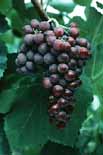
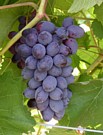
See the University of Arkansas web site for more information.
Grape breeders have responded to consumer preferences for seedless grapes with the development of numerous improved varieties. The seedless trait in grapes was originally derived from cultivars of ancient origin such as Thompson Seedless and Black Monukka. Most seedless grapes suitable for the eastern United States are descended from crosses with these two cultivars. Because the trait originated in cultivars not suitable for surviving the cold temperatures of New York winters, many seedless varieties are not sufficiently winter hardy (Table 2), although they are much hardier than their seedless parents. More recently named seedless cultivars (Canadice, Einset Seedless, Reliance, and Vanessa) represent a distinct improvement in cold hardiness. Breeding programs in New York, Ontario, Arkansas, and elsewhere continue to produce seedless selections with improved hardiness and quality. Promising selections from the New York program are available for test purposes only.
The degree of seedlessness varies greatly among seedless grape varieties. Most seedless grapes have vestigial seed traces that range in size from very small to large and noticeable. Seed traces in berries of the same variety may vary greatly in size and in the hardness of their seed coats. Climate is also known to affect seed trace size. Occasionally the seed traces in some seedless grapes are large enough to be bothersome to consumers. Notes on seed remnant sizes are given for varieties in which problems exist.
| Canadice is more winter hardy than most seedless grapes, although trunk injury has occurred on some sites. It produces medium clusters with small red berries that are similar to Delaware in flavor and appearance. With cordon training systems and careful management, Canadice clusters may average 0.5 lb., and the vines can be extremely productive. Fruit rot is a problem in wet years because the clusters are excessively compact. Cluster weight = 0.50 lb. Berry weight = 1.6 g | |
| Concord Seedless, though similar in flavor and texture to Concord, is unrelated. The clusters and berries are much smaller than those of Concord. The fruit matures earlier, has high flavor, and makes excellent pies and preserves. Productivity is erratic, and it is not recommended for commercial planting. In warm years, the variety produces fully developed seeds. | |
 |
Einset Seedless (Plant patent 6160) is a winter-hardy, red seedless grape with a unique, strawberrylike flavor. The medium-sized clusters produce bright red, ovoid berries that have good storage potential until the end of November. The clusters respond well to gibberellic acid or cane girdling to improve cluster compactness and berry size. The skin is slightly tough and adheres to the tender flesh. Cultural problems include susceptibility to fungal diseases (Table 2) and a seed remnant that is occasionally noticeable. Along with Vanessa, Einset Seedless probably has the most commercial promise of the red seedless varieties that can be grown successfully in New York. Cluster weight = 0.32 lb. Berry weight = 2.3 g |
| Himrod, produced from a cross between Ontario and Thompson Seedless, is the most successful table grape released from the Cornell University grape breeding program (1952). It produces large bunches of white seedless grapes with excellent, honeylike flavor and melting, juicy texture. The clusters are loosely filled, but cane girdling, gibberellic acid treatments, or thinning may be used to increase cluster compactness and improve berry size (Zabadal, 1992). The brittle rachis may break when handled, and the berries may shell in storage. The rachis is also subject to bunch stem necrosis, a poorly understood disorder that causes a shriveling of the cluster stem, often just before harvest. Despite these cultural defects, Himrod is currently the most commercially important of the seedless grapes grown in New York. Cluster weight = 0.36 lb. Berry weight = 2.1 g | |
 |
Jupiter (Plant patent 13,309)
produces naturally large, oval, firm, seedless blue berries on medium sized
clusters. Maturity is early to mid-season. The flavor is excellent, with
a mild muscat character. There is relatively little experience growing Jupiter
in New York. It is said to be very productive, and more winter hardy than
Marquis and Himrod, but not as hardy as Reliance and Mars. Berry weight
= 4 to 5 g in Arkansas See the University of Arkansas web site for more information. |
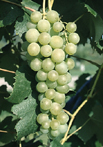 |
Marquis (Plant patent 11,012) was named and released at Geneva in 1996. Clusters are very large, medium compact, and attractive, with large, round, yellow-green berries (3.5 - 5.0 gm/berry). Texture is melting, and the taste is very flavorful. Ripe fruit holds well on the vine, with the flavors going from a mild fruity flavor when first ripe, to a stronger Labrusca flavor two weeks later. Giberrellic acid treatment is not recommended, but well-timed cluster thinning and cane girdling can increase berry size and improve cluster compactness. Vines are moderately hardy, medium in vigor and productive. For more information, see the Marquis Release Bulletin. |
| Mars (Plant patent 5680), a release from the University of Arkansas, is a vigorous, blue seedless grape. The flavor is mildly labrusca, similar to Campbell's Early, and the berries are slipskin (having a tough skin that separates readily from the pulpy flesh). Clusters are medium sized, cylindrical, and well filled. Hardiness has been good at Geneva, New York, and the vines are resistant to several major diseases. Vines may bear fruit precociously, and production should be controlled on young vines to prevent delays in establishment. Mars has been recommended in Arkansas as a home garden grape with limited potential for commercial marketing. Cluster weight = 0.40 lb. Berry weight = 2.6 g in Arkansas | |
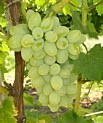 |
Neptune (Plant patent 12,302), a 1998 release from the University of Arkansas, is a yellow-green seedless grape cultivar of moderate vigor. The clusters are large and very showy, but productivity is moderate. Flavor is mild and fruity, while fruit texture is firm with a relatively thick skin, similar to many eastern seedless grapes. There is relatively little experience growing Neptune in New York. It is reported to be more winter hardy than Venus. Maturity was mid- to late-season in 2004. Berry weight = 3 g in Arkansas See the University of Arkansas web site for more information. |
| Reliance (Plant patent 5174),
also from the University of Arkansas (1982), produces large clusters of
round, red, medium-sized berries. The skins are tender and the flesh is
melting in texture, with a sweet labrusca flavor. Coloring may be poor in
some years, and fruit often crack in wet seasons. Cold hardiness is among
the highest of the seedless varieties. Cluster weight = 0.62 lb. Berry weight
= 2 to 3 g in Arkansas See the University of Arkansas web site for more information. |
|
| Remaily Seedless, developed by the New York State Agricultural Experiment Station, produces large clusters of oval seedless berries with firm texture. The flavor is neutral and mildly fruity. The clusters are very attractive in appearance but are subject to bronzing where exposed to sunlight, and the vines are only moderately hardy. This variety is recommended for backyard gardeners interested in a neutral-flavored, European-type grape that is more winter hardy than commercially grown California seedless grapes. Cluster weight = 0.68 lb. Berry weight = 2.7 g | |
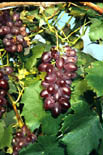 |
Saturn (Plant patent 6703),
another University of Arkansas release (1987), produces large, crisp berries
on medium-large conical clusters. The berries are bright red with adherent
skins and a mild flavor. Vines are precocious and moderately hardy at best
and must be cluster thinned. In some years the seed remnants are very noticeable.
Saturn has good storage potential and may be processed into an acceptable
blending wine. Cluster weight = 0.68 lb. Berry weight = 3.0 g in Arkansas See the University of Arkansas web site for more information. |
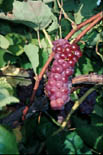 |
Suffolk Red produces medium to large clusters of mild-flavored red berries. The clusters are loose but may be made more compact with the use of gibberellic acid or cane girdling. Winter damage is often a problem except on Long Island, where the variety is successfully cultured. Excessive vine vigor may occur following poor crops and winter bud damage. Cluster weight = 0.32 lb. Berry weight = 2.7 g |
|
Venus, also from the University of Arkansas, is a vigorous and productive blue-black seedless grape. The medium-large clusters ripen early, producing large berries with mild labrusca flavors. In New York, the seed remnants are hard and noticeable, and fruit rot has been a problem at harvest. Fruit quality is only fair. Cluster weight = 0.60 lb. Berry weight = 2.9 g See the University of Arkansas web site for more information. |